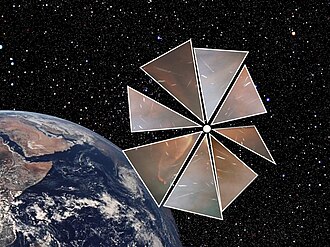
Artist drawing of Cosmos 1 Solar Sail
Specific Impulse I_s is defined as exhaust velocity V_e divided by gravitational acceleration at Earth's surface, g (which is 9.81 m/s^2):
$$ I_s = \frac{V_e}{g} $$
To use specific impulse in Tsiolkovsky's Rocket Equation, we need to multiply it with g.
$$ \Delta V = I_s g \times \ln\left(\frac{m_1}{m_2}\right) $$
But why do this? Why not just use the exhaust velocity? We already know higher exhaust velocities are more efficient and produce higher delta V for given amount of fuel.
Well, partly because it's a way to compare different propulsion technologies. For example solar sails aren't rockets, so we can't really talk about exhaust velocities. But we can talk about its specific impulse, which is analogous to efficiency of propulsion.
We can compare different rocket engines that have different fuel/oxidizer pumping technologies.
Specific impulse indicates how much delta v is produced for a given amount of fuel, if we're talking about rockets.
Liquid fuel engines are broadly categorised into "open cycle" and "closed cycle".
In "closed cycle", it is as before, but the burned fuel/oxygen used to drive the pump is fed into the main combustion chamber and contributes to the thrust.
Now, in both cases, the fuel used is the same, the combustion temperature is the same, the nozzle shape is the same. Thus strictly speaking, they both have the same exhaust velocity. But the closed cycle has a higher specific impulse than the open cycle, because all the fuel contributes to thrust.
Open cycle engines use more fuel to attain the same delta v because some of it is dumped after using it to power the pump. It has lower specific impulse, which has the effect analogous to having lower exhaust velocity, even though it actually has the same exhaust velocity, if using the same fuel and nozzle.
On the other hand, closed cycle engines are harder to build. You're trying to feed burned fuel into a high pressure combustion chamber. You could get backwash if you're not careful. High pressure gas from the combustion chamber forcing back into the turbine.
Specific impulse indicates how much delta v is produced for a given amount of fuel, if we're talking about rockets.

Artist drawing of Cosmos 1 Solar Sail
Anyway here's a little table with an open loop, closed loop, ion engine, solar sail, nuclear-thermal. Source from Wikipidea and Encyclopedia Astronautica.
| Engine/Propulsion | Specific Impulse | Exhaust Velocity | Thrust |
|---|---|---|---|
| Liquid fueled (Open cycle) |
|||
| Liquid fueled (Closed cycle) |
|||
| Nuclear Thermal | |||
| Ionic Propulsion | |||
| Solar Sail | |||